Applied Corporate Strategy: A Case Study of Sainsbury
VerifiedAdded on 2023/01/12
|13
|3846
|31
AI Summary
This report provides a case study on the applied corporate strategy of Sainsbury, focusing on the Sainsbury Asda Merger. It includes an external analysis, assessment of industry attractiveness, internal analysis with frameworks like PESTLE Analysis and Porter's Five Forces, and evaluation with SAFe criteria.
Contribute Materials
Your contribution can guide someone’s learning journey. Share your
documents today.
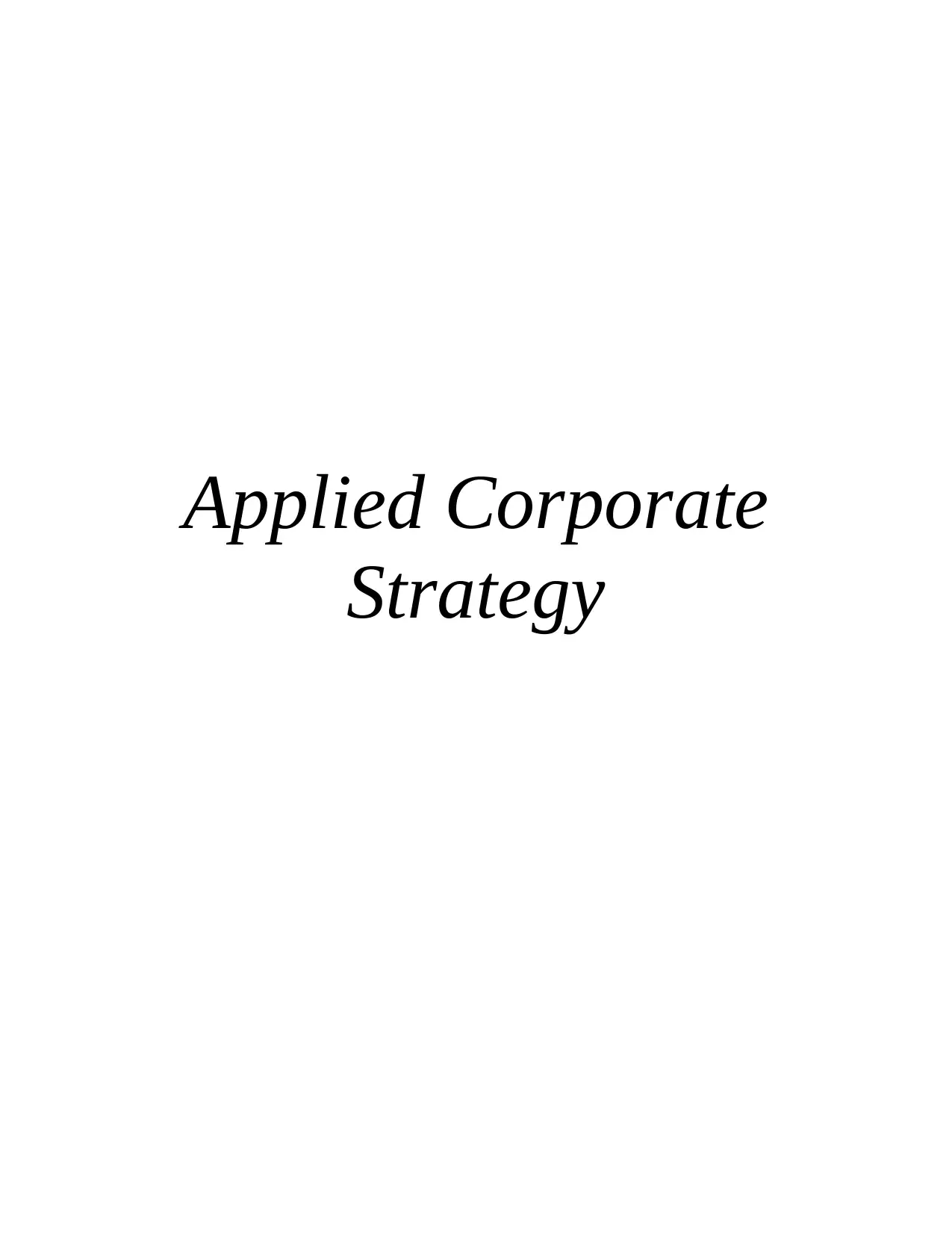
Applied Corporate
Strategy
Strategy
Secure Best Marks with AI Grader
Need help grading? Try our AI Grader for instant feedback on your assignments.
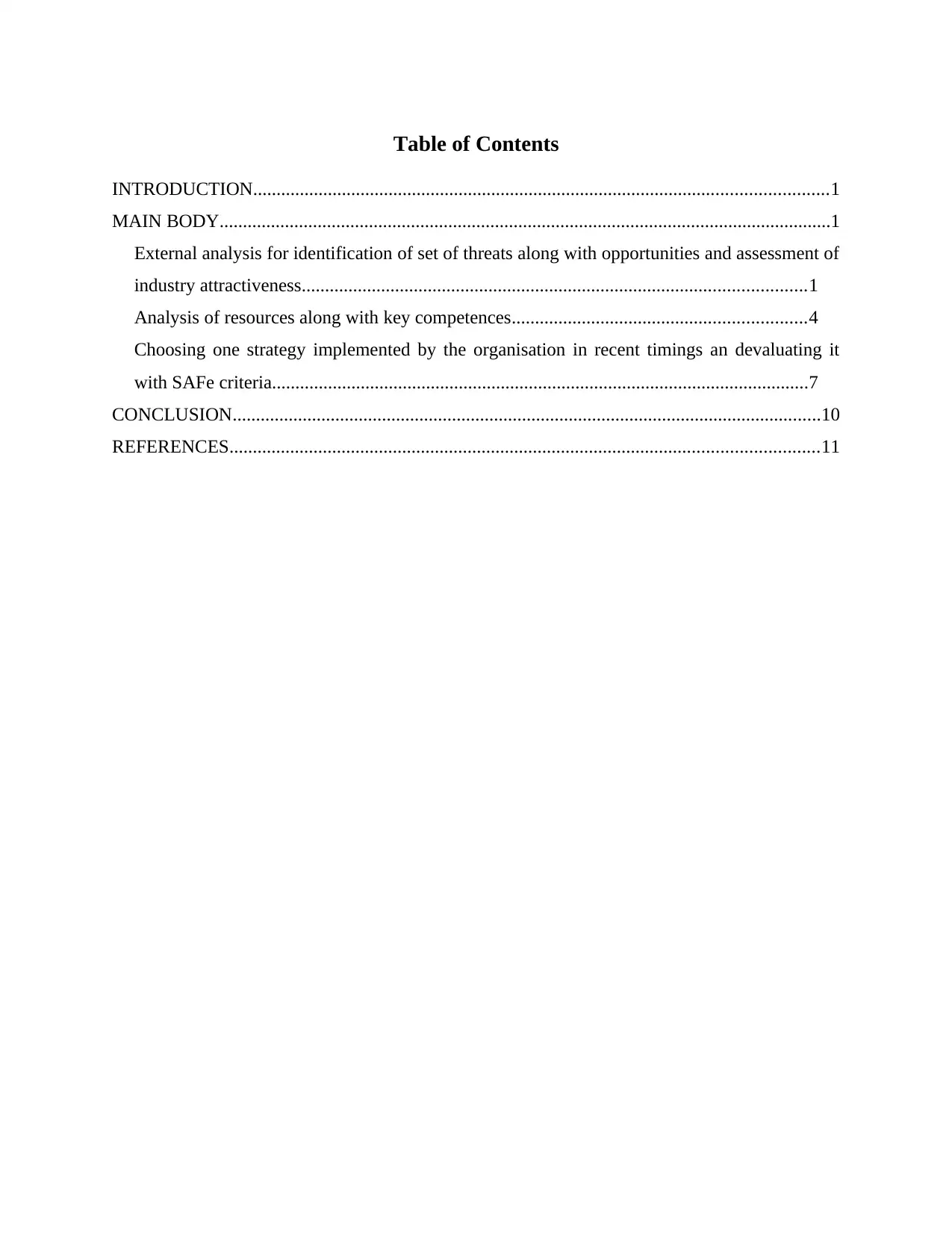
Table of Contents
INTRODUCTION...........................................................................................................................1
MAIN BODY...................................................................................................................................1
External analysis for identification of set of threats along with opportunities and assessment of
industry attractiveness............................................................................................................1
Analysis of resources along with key competences...............................................................4
Choosing one strategy implemented by the organisation in recent timings an devaluating it
with SAFe criteria...................................................................................................................7
CONCLUSION..............................................................................................................................10
REFERENCES..............................................................................................................................11
INTRODUCTION...........................................................................................................................1
MAIN BODY...................................................................................................................................1
External analysis for identification of set of threats along with opportunities and assessment of
industry attractiveness............................................................................................................1
Analysis of resources along with key competences...............................................................4
Choosing one strategy implemented by the organisation in recent timings an devaluating it
with SAFe criteria...................................................................................................................7
CONCLUSION..............................................................................................................................10
REFERENCES..............................................................................................................................11
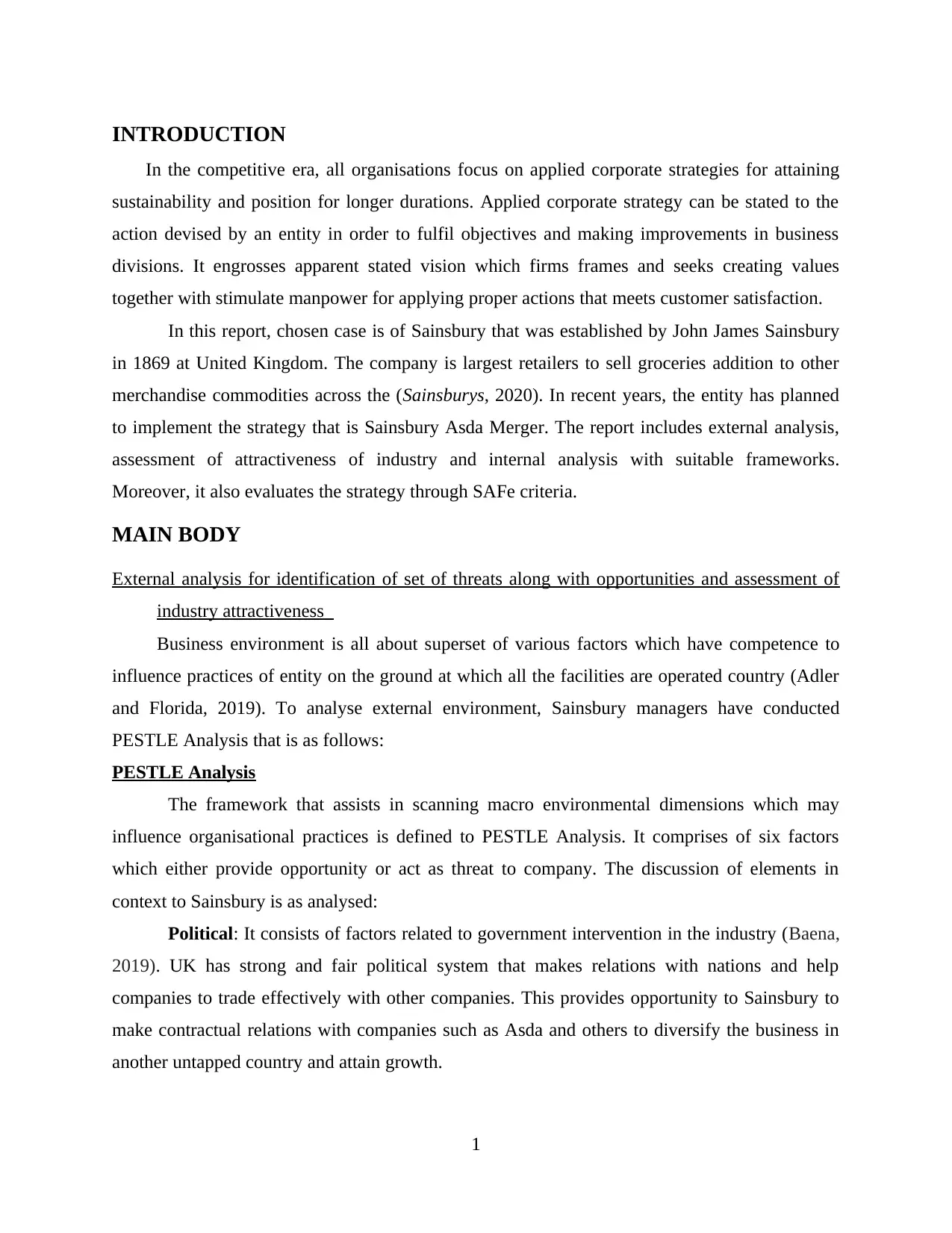
INTRODUCTION
In the competitive era, all organisations focus on applied corporate strategies for attaining
sustainability and position for longer durations. Applied corporate strategy can be stated to the
action devised by an entity in order to fulfil objectives and making improvements in business
divisions. It engrosses apparent stated vision which firms frames and seeks creating values
together with stimulate manpower for applying proper actions that meets customer satisfaction.
In this report, chosen case is of Sainsbury that was established by John James Sainsbury
in 1869 at United Kingdom. The company is largest retailers to sell groceries addition to other
merchandise commodities across the (Sainsburys, 2020). In recent years, the entity has planned
to implement the strategy that is Sainsbury Asda Merger. The report includes external analysis,
assessment of attractiveness of industry and internal analysis with suitable frameworks.
Moreover, it also evaluates the strategy through SAFe criteria.
MAIN BODY
External analysis for identification of set of threats along with opportunities and assessment of
industry attractiveness
Business environment is all about superset of various factors which have competence to
influence practices of entity on the ground at which all the facilities are operated country (Adler
and Florida, 2019). To analyse external environment, Sainsbury managers have conducted
PESTLE Analysis that is as follows:
PESTLE Analysis
The framework that assists in scanning macro environmental dimensions which may
influence organisational practices is defined to PESTLE Analysis. It comprises of six factors
which either provide opportunity or act as threat to company. The discussion of elements in
context to Sainsbury is as analysed:
Political: It consists of factors related to government intervention in the industry (Baena,
2019). UK has strong and fair political system that makes relations with nations and help
companies to trade effectively with other companies. This provides opportunity to Sainsbury to
make contractual relations with companies such as Asda and others to diversify the business in
another untapped country and attain growth.
1
In the competitive era, all organisations focus on applied corporate strategies for attaining
sustainability and position for longer durations. Applied corporate strategy can be stated to the
action devised by an entity in order to fulfil objectives and making improvements in business
divisions. It engrosses apparent stated vision which firms frames and seeks creating values
together with stimulate manpower for applying proper actions that meets customer satisfaction.
In this report, chosen case is of Sainsbury that was established by John James Sainsbury
in 1869 at United Kingdom. The company is largest retailers to sell groceries addition to other
merchandise commodities across the (Sainsburys, 2020). In recent years, the entity has planned
to implement the strategy that is Sainsbury Asda Merger. The report includes external analysis,
assessment of attractiveness of industry and internal analysis with suitable frameworks.
Moreover, it also evaluates the strategy through SAFe criteria.
MAIN BODY
External analysis for identification of set of threats along with opportunities and assessment of
industry attractiveness
Business environment is all about superset of various factors which have competence to
influence practices of entity on the ground at which all the facilities are operated country (Adler
and Florida, 2019). To analyse external environment, Sainsbury managers have conducted
PESTLE Analysis that is as follows:
PESTLE Analysis
The framework that assists in scanning macro environmental dimensions which may
influence organisational practices is defined to PESTLE Analysis. It comprises of six factors
which either provide opportunity or act as threat to company. The discussion of elements in
context to Sainsbury is as analysed:
Political: It consists of factors related to government intervention in the industry (Baena,
2019). UK has strong and fair political system that makes relations with nations and help
companies to trade effectively with other companies. This provides opportunity to Sainsbury to
make contractual relations with companies such as Asda and others to diversify the business in
another untapped country and attain growth.
1
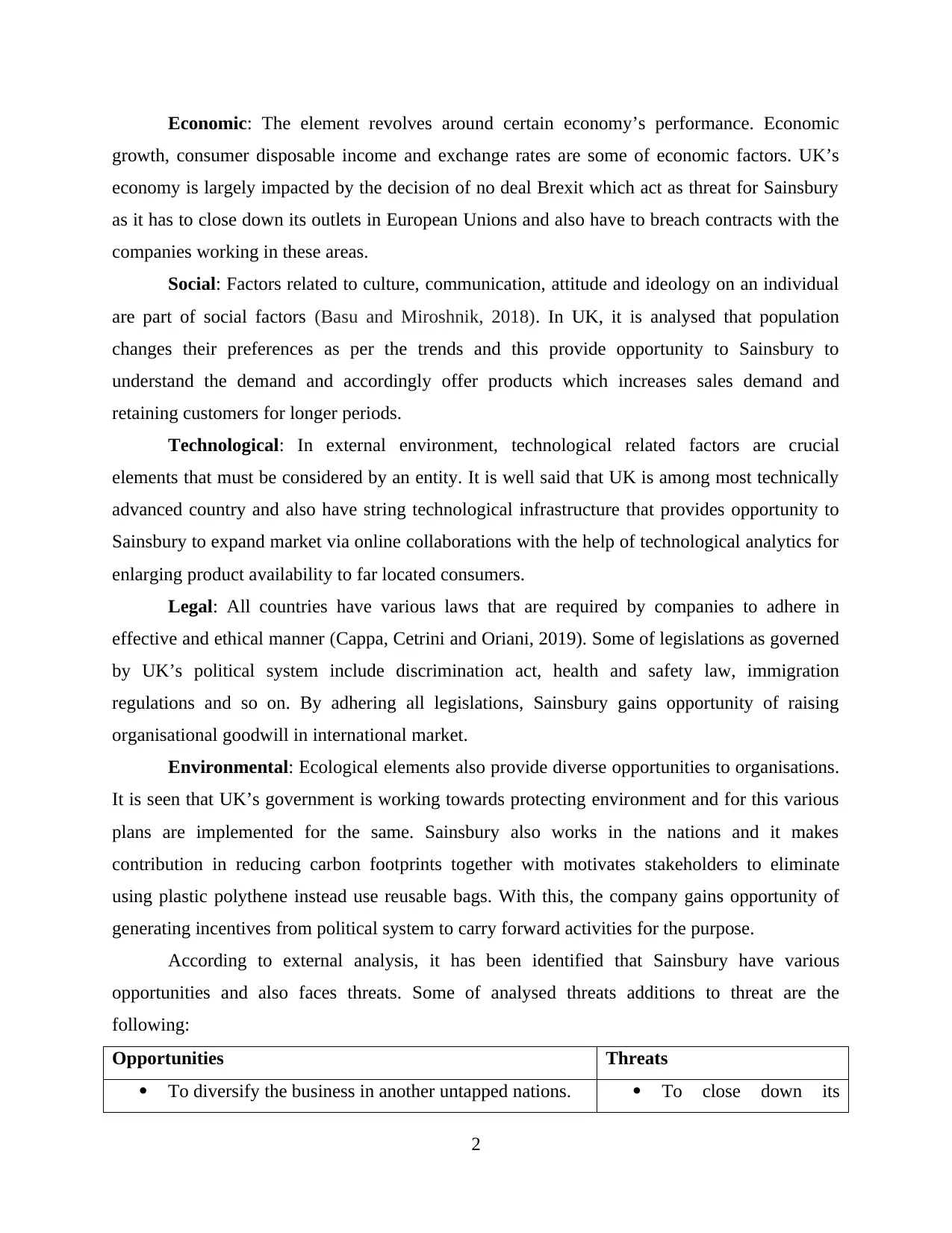
Economic: The element revolves around certain economy’s performance. Economic
growth, consumer disposable income and exchange rates are some of economic factors. UK’s
economy is largely impacted by the decision of no deal Brexit which act as threat for Sainsbury
as it has to close down its outlets in European Unions and also have to breach contracts with the
companies working in these areas.
Social: Factors related to culture, communication, attitude and ideology on an individual
are part of social factors (Basu and Miroshnik, 2018). In UK, it is analysed that population
changes their preferences as per the trends and this provide opportunity to Sainsbury to
understand the demand and accordingly offer products which increases sales demand and
retaining customers for longer periods.
Technological: In external environment, technological related factors are crucial
elements that must be considered by an entity. It is well said that UK is among most technically
advanced country and also have string technological infrastructure that provides opportunity to
Sainsbury to expand market via online collaborations with the help of technological analytics for
enlarging product availability to far located consumers.
Legal: All countries have various laws that are required by companies to adhere in
effective and ethical manner (Cappa, Cetrini and Oriani, 2019). Some of legislations as governed
by UK’s political system include discrimination act, health and safety law, immigration
regulations and so on. By adhering all legislations, Sainsbury gains opportunity of raising
organisational goodwill in international market.
Environmental: Ecological elements also provide diverse opportunities to organisations.
It is seen that UK’s government is working towards protecting environment and for this various
plans are implemented for the same. Sainsbury also works in the nations and it makes
contribution in reducing carbon footprints together with motivates stakeholders to eliminate
using plastic polythene instead use reusable bags. With this, the company gains opportunity of
generating incentives from political system to carry forward activities for the purpose.
According to external analysis, it has been identified that Sainsbury have various
opportunities and also faces threats. Some of analysed threats additions to threat are the
following:
Opportunities Threats
To diversify the business in another untapped nations. To close down its
2
growth, consumer disposable income and exchange rates are some of economic factors. UK’s
economy is largely impacted by the decision of no deal Brexit which act as threat for Sainsbury
as it has to close down its outlets in European Unions and also have to breach contracts with the
companies working in these areas.
Social: Factors related to culture, communication, attitude and ideology on an individual
are part of social factors (Basu and Miroshnik, 2018). In UK, it is analysed that population
changes their preferences as per the trends and this provide opportunity to Sainsbury to
understand the demand and accordingly offer products which increases sales demand and
retaining customers for longer periods.
Technological: In external environment, technological related factors are crucial
elements that must be considered by an entity. It is well said that UK is among most technically
advanced country and also have string technological infrastructure that provides opportunity to
Sainsbury to expand market via online collaborations with the help of technological analytics for
enlarging product availability to far located consumers.
Legal: All countries have various laws that are required by companies to adhere in
effective and ethical manner (Cappa, Cetrini and Oriani, 2019). Some of legislations as governed
by UK’s political system include discrimination act, health and safety law, immigration
regulations and so on. By adhering all legislations, Sainsbury gains opportunity of raising
organisational goodwill in international market.
Environmental: Ecological elements also provide diverse opportunities to organisations.
It is seen that UK’s government is working towards protecting environment and for this various
plans are implemented for the same. Sainsbury also works in the nations and it makes
contribution in reducing carbon footprints together with motivates stakeholders to eliminate
using plastic polythene instead use reusable bags. With this, the company gains opportunity of
generating incentives from political system to carry forward activities for the purpose.
According to external analysis, it has been identified that Sainsbury have various
opportunities and also faces threats. Some of analysed threats additions to threat are the
following:
Opportunities Threats
To diversify the business in another untapped nations. To close down its
2
Secure Best Marks with AI Grader
Need help grading? Try our AI Grader for instant feedback on your assignments.
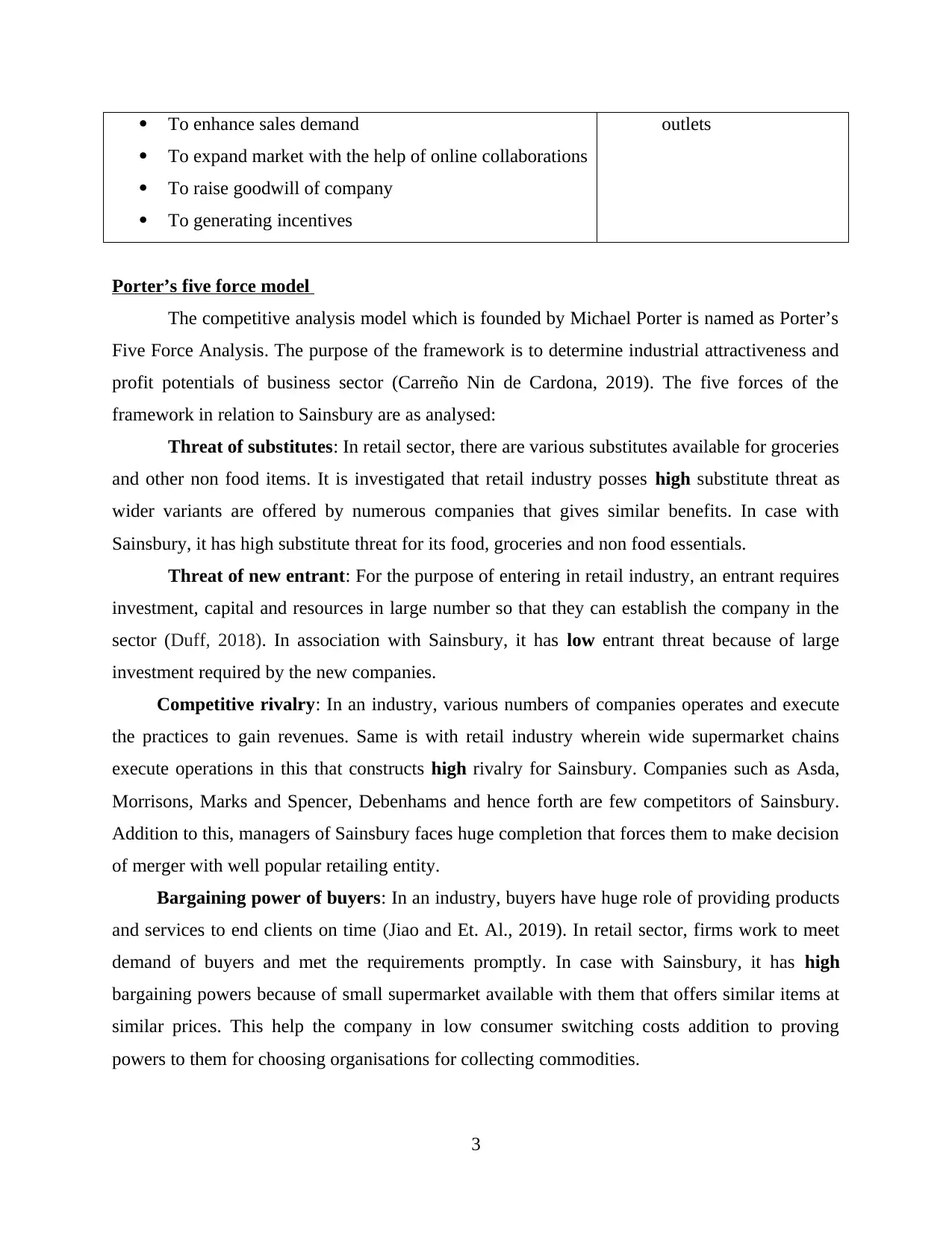
To enhance sales demand
To expand market with the help of online collaborations
To raise goodwill of company
To generating incentives
outlets
Porter’s five force model
The competitive analysis model which is founded by Michael Porter is named as Porter’s
Five Force Analysis. The purpose of the framework is to determine industrial attractiveness and
profit potentials of business sector (Carreño Nin de Cardona, 2019). The five forces of the
framework in relation to Sainsbury are as analysed:
Threat of substitutes: In retail sector, there are various substitutes available for groceries
and other non food items. It is investigated that retail industry posses high substitute threat as
wider variants are offered by numerous companies that gives similar benefits. In case with
Sainsbury, it has high substitute threat for its food, groceries and non food essentials.
Threat of new entrant: For the purpose of entering in retail industry, an entrant requires
investment, capital and resources in large number so that they can establish the company in the
sector (Duff, 2018). In association with Sainsbury, it has low entrant threat because of large
investment required by the new companies.
Competitive rivalry: In an industry, various numbers of companies operates and execute
the practices to gain revenues. Same is with retail industry wherein wide supermarket chains
execute operations in this that constructs high rivalry for Sainsbury. Companies such as Asda,
Morrisons, Marks and Spencer, Debenhams and hence forth are few competitors of Sainsbury.
Addition to this, managers of Sainsbury faces huge completion that forces them to make decision
of merger with well popular retailing entity.
Bargaining power of buyers: In an industry, buyers have huge role of providing products
and services to end clients on time (Jiao and Et. Al., 2019). In retail sector, firms work to meet
demand of buyers and met the requirements promptly. In case with Sainsbury, it has high
bargaining powers because of small supermarket available with them that offers similar items at
similar prices. This help the company in low consumer switching costs addition to proving
powers to them for choosing organisations for collecting commodities.
3
To expand market with the help of online collaborations
To raise goodwill of company
To generating incentives
outlets
Porter’s five force model
The competitive analysis model which is founded by Michael Porter is named as Porter’s
Five Force Analysis. The purpose of the framework is to determine industrial attractiveness and
profit potentials of business sector (Carreño Nin de Cardona, 2019). The five forces of the
framework in relation to Sainsbury are as analysed:
Threat of substitutes: In retail sector, there are various substitutes available for groceries
and other non food items. It is investigated that retail industry posses high substitute threat as
wider variants are offered by numerous companies that gives similar benefits. In case with
Sainsbury, it has high substitute threat for its food, groceries and non food essentials.
Threat of new entrant: For the purpose of entering in retail industry, an entrant requires
investment, capital and resources in large number so that they can establish the company in the
sector (Duff, 2018). In association with Sainsbury, it has low entrant threat because of large
investment required by the new companies.
Competitive rivalry: In an industry, various numbers of companies operates and execute
the practices to gain revenues. Same is with retail industry wherein wide supermarket chains
execute operations in this that constructs high rivalry for Sainsbury. Companies such as Asda,
Morrisons, Marks and Spencer, Debenhams and hence forth are few competitors of Sainsbury.
Addition to this, managers of Sainsbury faces huge completion that forces them to make decision
of merger with well popular retailing entity.
Bargaining power of buyers: In an industry, buyers have huge role of providing products
and services to end clients on time (Jiao and Et. Al., 2019). In retail sector, firms work to meet
demand of buyers and met the requirements promptly. In case with Sainsbury, it has high
bargaining powers because of small supermarket available with them that offers similar items at
similar prices. This help the company in low consumer switching costs addition to proving
powers to them for choosing organisations for collecting commodities.
3
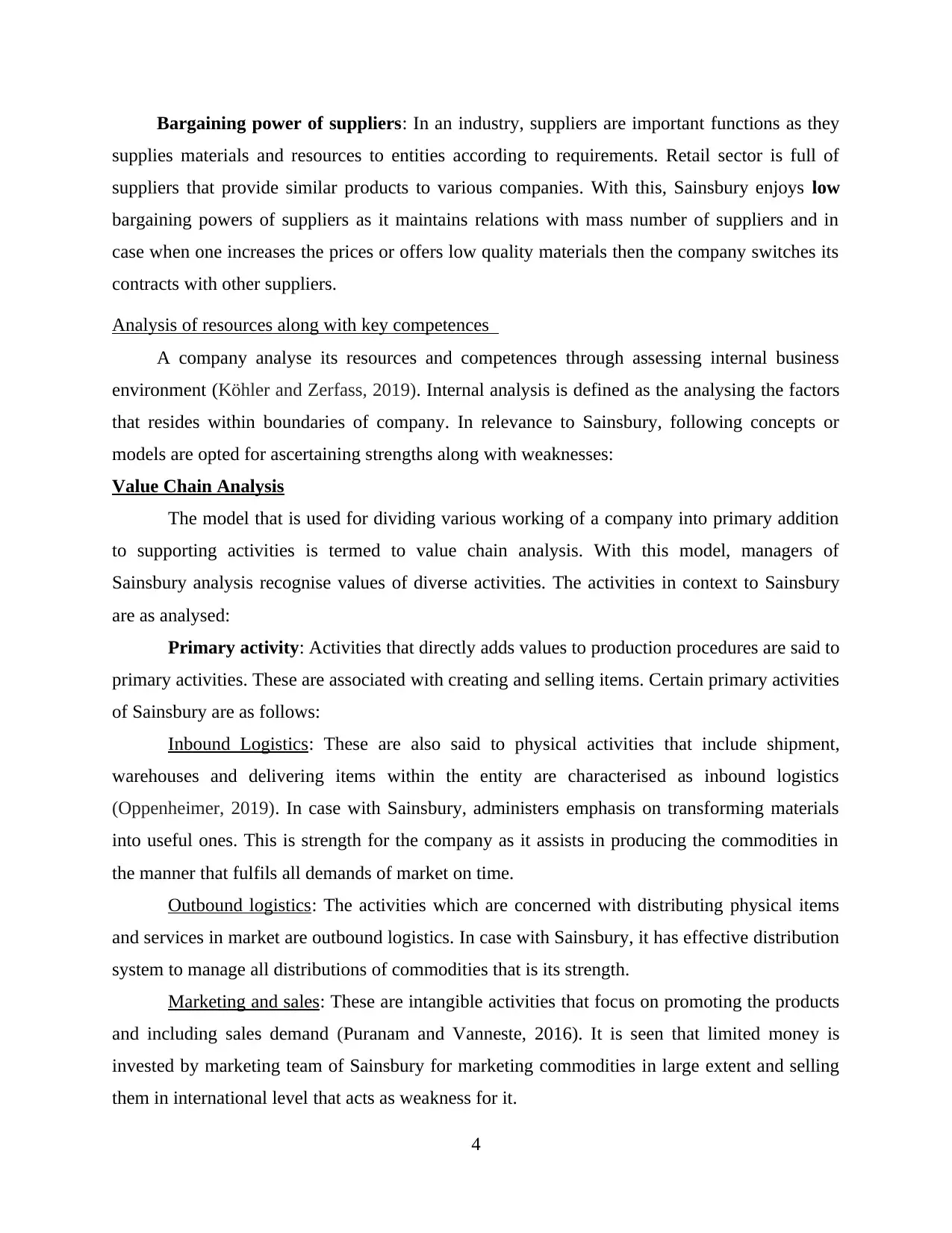
Bargaining power of suppliers: In an industry, suppliers are important functions as they
supplies materials and resources to entities according to requirements. Retail sector is full of
suppliers that provide similar products to various companies. With this, Sainsbury enjoys low
bargaining powers of suppliers as it maintains relations with mass number of suppliers and in
case when one increases the prices or offers low quality materials then the company switches its
contracts with other suppliers.
Analysis of resources along with key competences
A company analyse its resources and competences through assessing internal business
environment (Köhler and Zerfass, 2019). Internal analysis is defined as the analysing the factors
that resides within boundaries of company. In relevance to Sainsbury, following concepts or
models are opted for ascertaining strengths along with weaknesses:
Value Chain Analysis
The model that is used for dividing various working of a company into primary addition
to supporting activities is termed to value chain analysis. With this model, managers of
Sainsbury analysis recognise values of diverse activities. The activities in context to Sainsbury
are as analysed:
Primary activity: Activities that directly adds values to production procedures are said to
primary activities. These are associated with creating and selling items. Certain primary activities
of Sainsbury are as follows:
Inbound Logistics: These are also said to physical activities that include shipment,
warehouses and delivering items within the entity are characterised as inbound logistics
(Oppenheimer, 2019). In case with Sainsbury, administers emphasis on transforming materials
into useful ones. This is strength for the company as it assists in producing the commodities in
the manner that fulfils all demands of market on time.
Outbound logistics: The activities which are concerned with distributing physical items
and services in market are outbound logistics. In case with Sainsbury, it has effective distribution
system to manage all distributions of commodities that is its strength.
Marketing and sales: These are intangible activities that focus on promoting the products
and including sales demand (Puranam and Vanneste, 2016). It is seen that limited money is
invested by marketing team of Sainsbury for marketing commodities in large extent and selling
them in international level that acts as weakness for it.
4
supplies materials and resources to entities according to requirements. Retail sector is full of
suppliers that provide similar products to various companies. With this, Sainsbury enjoys low
bargaining powers of suppliers as it maintains relations with mass number of suppliers and in
case when one increases the prices or offers low quality materials then the company switches its
contracts with other suppliers.
Analysis of resources along with key competences
A company analyse its resources and competences through assessing internal business
environment (Köhler and Zerfass, 2019). Internal analysis is defined as the analysing the factors
that resides within boundaries of company. In relevance to Sainsbury, following concepts or
models are opted for ascertaining strengths along with weaknesses:
Value Chain Analysis
The model that is used for dividing various working of a company into primary addition
to supporting activities is termed to value chain analysis. With this model, managers of
Sainsbury analysis recognise values of diverse activities. The activities in context to Sainsbury
are as analysed:
Primary activity: Activities that directly adds values to production procedures are said to
primary activities. These are associated with creating and selling items. Certain primary activities
of Sainsbury are as follows:
Inbound Logistics: These are also said to physical activities that include shipment,
warehouses and delivering items within the entity are characterised as inbound logistics
(Oppenheimer, 2019). In case with Sainsbury, administers emphasis on transforming materials
into useful ones. This is strength for the company as it assists in producing the commodities in
the manner that fulfils all demands of market on time.
Outbound logistics: The activities which are concerned with distributing physical items
and services in market are outbound logistics. In case with Sainsbury, it has effective distribution
system to manage all distributions of commodities that is its strength.
Marketing and sales: These are intangible activities that focus on promoting the products
and including sales demand (Puranam and Vanneste, 2016). It is seen that limited money is
invested by marketing team of Sainsbury for marketing commodities in large extent and selling
them in international level that acts as weakness for it.
4
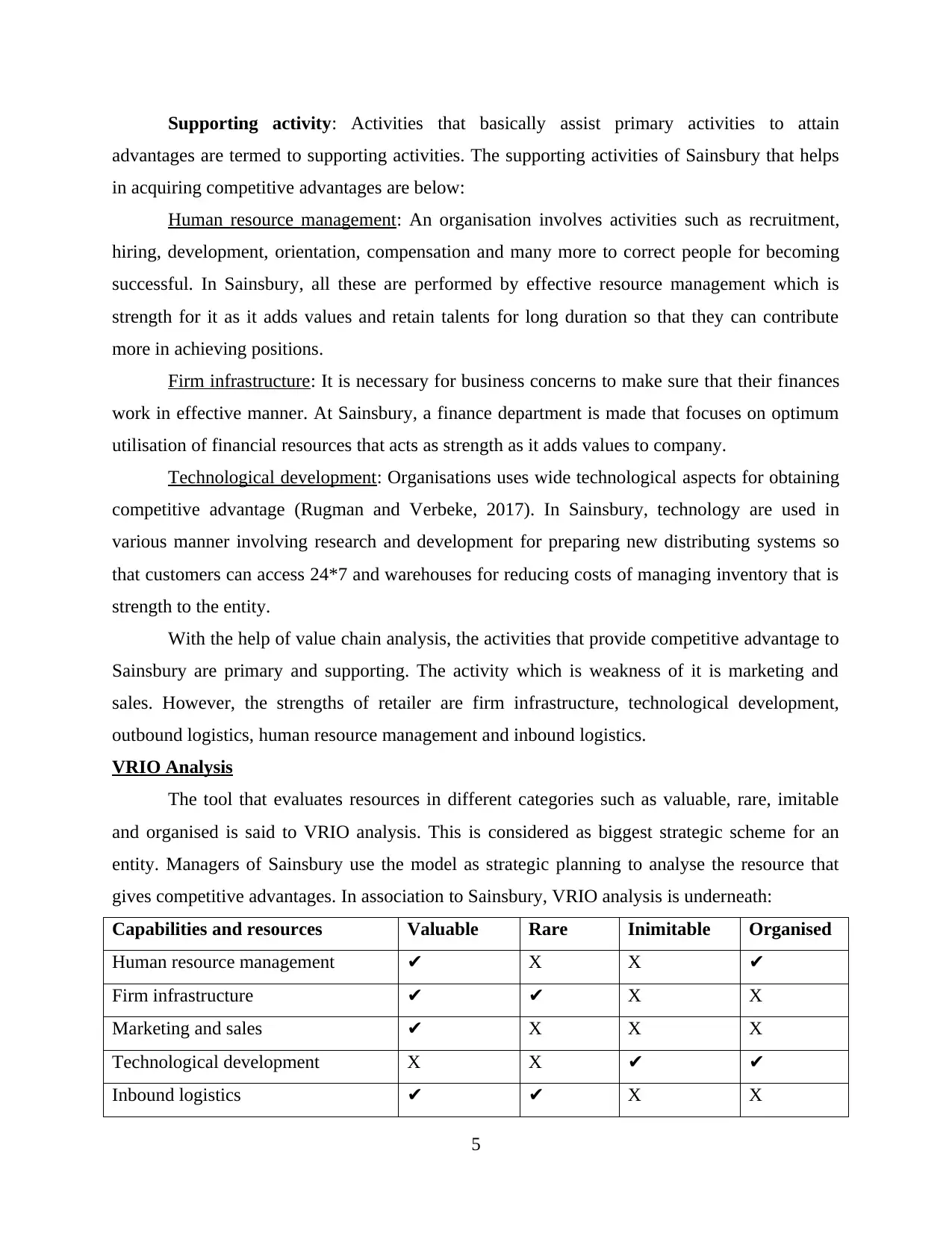
Supporting activity: Activities that basically assist primary activities to attain
advantages are termed to supporting activities. The supporting activities of Sainsbury that helps
in acquiring competitive advantages are below:
Human resource management: An organisation involves activities such as recruitment,
hiring, development, orientation, compensation and many more to correct people for becoming
successful. In Sainsbury, all these are performed by effective resource management which is
strength for it as it adds values and retain talents for long duration so that they can contribute
more in achieving positions.
Firm infrastructure: It is necessary for business concerns to make sure that their finances
work in effective manner. At Sainsbury, a finance department is made that focuses on optimum
utilisation of financial resources that acts as strength as it adds values to company.
Technological development: Organisations uses wide technological aspects for obtaining
competitive advantage (Rugman and Verbeke, 2017). In Sainsbury, technology are used in
various manner involving research and development for preparing new distributing systems so
that customers can access 24*7 and warehouses for reducing costs of managing inventory that is
strength to the entity.
With the help of value chain analysis, the activities that provide competitive advantage to
Sainsbury are primary and supporting. The activity which is weakness of it is marketing and
sales. However, the strengths of retailer are firm infrastructure, technological development,
outbound logistics, human resource management and inbound logistics.
VRIO Analysis
The tool that evaluates resources in different categories such as valuable, rare, imitable
and organised is said to VRIO analysis. This is considered as biggest strategic scheme for an
entity. Managers of Sainsbury use the model as strategic planning to analyse the resource that
gives competitive advantages. In association to Sainsbury, VRIO analysis is underneath:
Capabilities and resources Valuable Rare Inimitable Organised
Human resource management ✔ X X ✔
Firm infrastructure ✔ ✔ X X
Marketing and sales ✔ X X X
Technological development X X ✔ ✔
Inbound logistics ✔ ✔ X X
5
advantages are termed to supporting activities. The supporting activities of Sainsbury that helps
in acquiring competitive advantages are below:
Human resource management: An organisation involves activities such as recruitment,
hiring, development, orientation, compensation and many more to correct people for becoming
successful. In Sainsbury, all these are performed by effective resource management which is
strength for it as it adds values and retain talents for long duration so that they can contribute
more in achieving positions.
Firm infrastructure: It is necessary for business concerns to make sure that their finances
work in effective manner. At Sainsbury, a finance department is made that focuses on optimum
utilisation of financial resources that acts as strength as it adds values to company.
Technological development: Organisations uses wide technological aspects for obtaining
competitive advantage (Rugman and Verbeke, 2017). In Sainsbury, technology are used in
various manner involving research and development for preparing new distributing systems so
that customers can access 24*7 and warehouses for reducing costs of managing inventory that is
strength to the entity.
With the help of value chain analysis, the activities that provide competitive advantage to
Sainsbury are primary and supporting. The activity which is weakness of it is marketing and
sales. However, the strengths of retailer are firm infrastructure, technological development,
outbound logistics, human resource management and inbound logistics.
VRIO Analysis
The tool that evaluates resources in different categories such as valuable, rare, imitable
and organised is said to VRIO analysis. This is considered as biggest strategic scheme for an
entity. Managers of Sainsbury use the model as strategic planning to analyse the resource that
gives competitive advantages. In association to Sainsbury, VRIO analysis is underneath:
Capabilities and resources Valuable Rare Inimitable Organised
Human resource management ✔ X X ✔
Firm infrastructure ✔ ✔ X X
Marketing and sales ✔ X X X
Technological development X X ✔ ✔
Inbound logistics ✔ ✔ X X
5
Paraphrase This Document
Need a fresh take? Get an instant paraphrase of this document with our AI Paraphraser
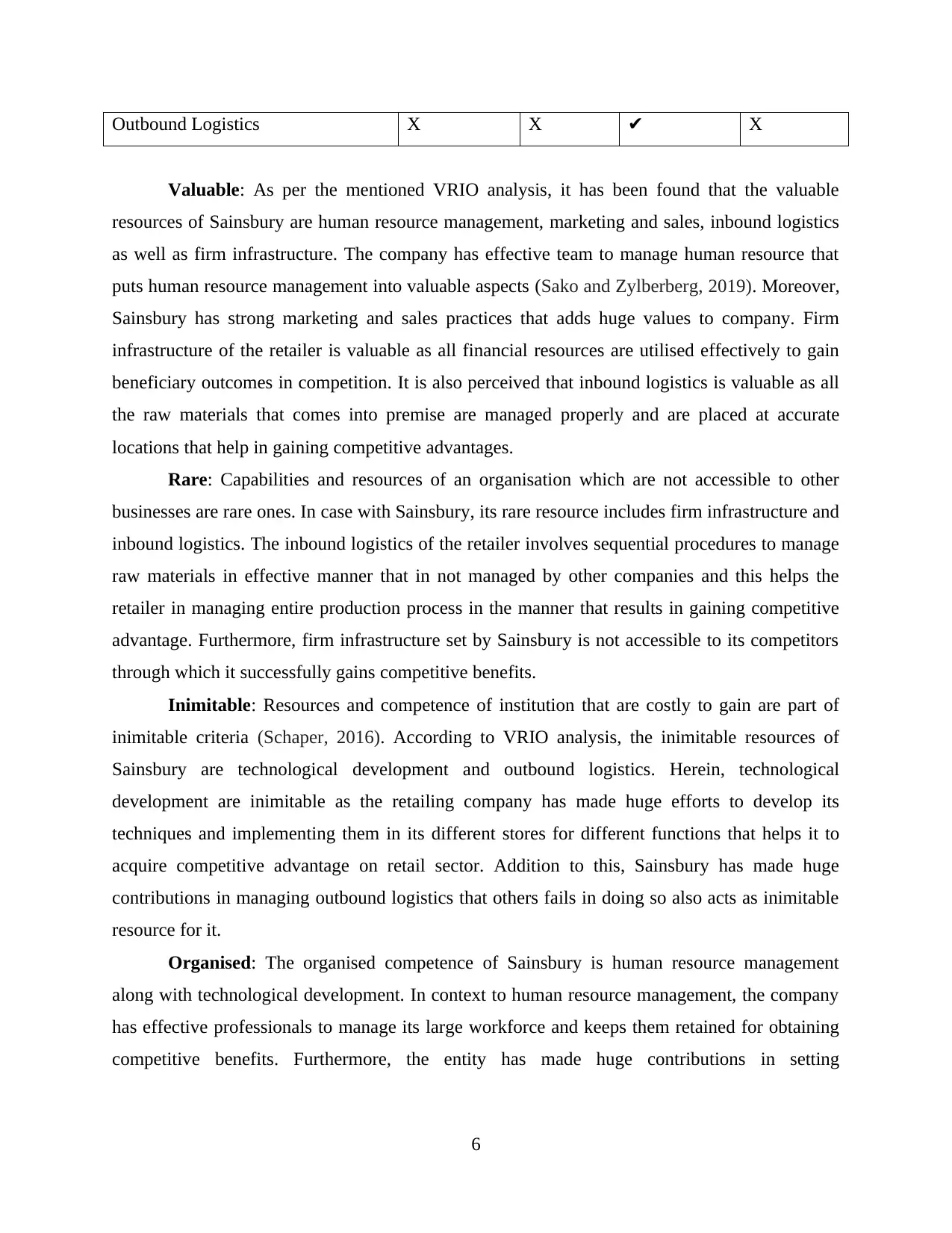
Outbound Logistics X X ✔ X
Valuable: As per the mentioned VRIO analysis, it has been found that the valuable
resources of Sainsbury are human resource management, marketing and sales, inbound logistics
as well as firm infrastructure. The company has effective team to manage human resource that
puts human resource management into valuable aspects (Sako and Zylberberg, 2019). Moreover,
Sainsbury has strong marketing and sales practices that adds huge values to company. Firm
infrastructure of the retailer is valuable as all financial resources are utilised effectively to gain
beneficiary outcomes in competition. It is also perceived that inbound logistics is valuable as all
the raw materials that comes into premise are managed properly and are placed at accurate
locations that help in gaining competitive advantages.
Rare: Capabilities and resources of an organisation which are not accessible to other
businesses are rare ones. In case with Sainsbury, its rare resource includes firm infrastructure and
inbound logistics. The inbound logistics of the retailer involves sequential procedures to manage
raw materials in effective manner that in not managed by other companies and this helps the
retailer in managing entire production process in the manner that results in gaining competitive
advantage. Furthermore, firm infrastructure set by Sainsbury is not accessible to its competitors
through which it successfully gains competitive benefits.
Inimitable: Resources and competence of institution that are costly to gain are part of
inimitable criteria (Schaper, 2016). According to VRIO analysis, the inimitable resources of
Sainsbury are technological development and outbound logistics. Herein, technological
development are inimitable as the retailing company has made huge efforts to develop its
techniques and implementing them in its different stores for different functions that helps it to
acquire competitive advantage on retail sector. Addition to this, Sainsbury has made huge
contributions in managing outbound logistics that others fails in doing so also acts as inimitable
resource for it.
Organised: The organised competence of Sainsbury is human resource management
along with technological development. In context to human resource management, the company
has effective professionals to manage its large workforce and keeps them retained for obtaining
competitive benefits. Furthermore, the entity has made huge contributions in setting
6
Valuable: As per the mentioned VRIO analysis, it has been found that the valuable
resources of Sainsbury are human resource management, marketing and sales, inbound logistics
as well as firm infrastructure. The company has effective team to manage human resource that
puts human resource management into valuable aspects (Sako and Zylberberg, 2019). Moreover,
Sainsbury has strong marketing and sales practices that adds huge values to company. Firm
infrastructure of the retailer is valuable as all financial resources are utilised effectively to gain
beneficiary outcomes in competition. It is also perceived that inbound logistics is valuable as all
the raw materials that comes into premise are managed properly and are placed at accurate
locations that help in gaining competitive advantages.
Rare: Capabilities and resources of an organisation which are not accessible to other
businesses are rare ones. In case with Sainsbury, its rare resource includes firm infrastructure and
inbound logistics. The inbound logistics of the retailer involves sequential procedures to manage
raw materials in effective manner that in not managed by other companies and this helps the
retailer in managing entire production process in the manner that results in gaining competitive
advantage. Furthermore, firm infrastructure set by Sainsbury is not accessible to its competitors
through which it successfully gains competitive benefits.
Inimitable: Resources and competence of institution that are costly to gain are part of
inimitable criteria (Schaper, 2016). According to VRIO analysis, the inimitable resources of
Sainsbury are technological development and outbound logistics. Herein, technological
development are inimitable as the retailing company has made huge efforts to develop its
techniques and implementing them in its different stores for different functions that helps it to
acquire competitive advantage on retail sector. Addition to this, Sainsbury has made huge
contributions in managing outbound logistics that others fails in doing so also acts as inimitable
resource for it.
Organised: The organised competence of Sainsbury is human resource management
along with technological development. In context to human resource management, the company
has effective professionals to manage its large workforce and keeps them retained for obtaining
competitive benefits. Furthermore, the entity has made huge contributions in setting
6
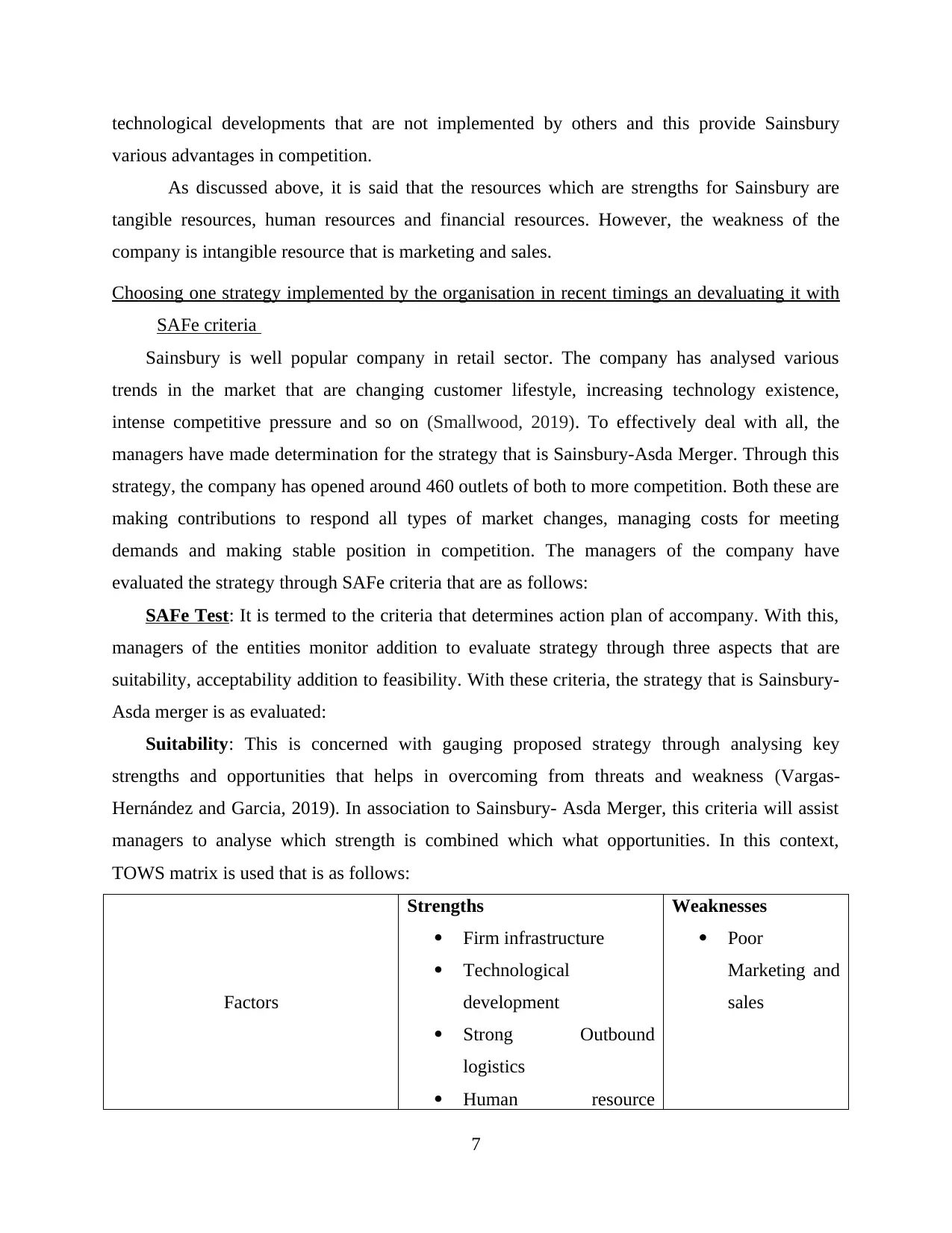
technological developments that are not implemented by others and this provide Sainsbury
various advantages in competition.
As discussed above, it is said that the resources which are strengths for Sainsbury are
tangible resources, human resources and financial resources. However, the weakness of the
company is intangible resource that is marketing and sales.
Choosing one strategy implemented by the organisation in recent timings an devaluating it with
SAFe criteria
Sainsbury is well popular company in retail sector. The company has analysed various
trends in the market that are changing customer lifestyle, increasing technology existence,
intense competitive pressure and so on (Smallwood, 2019). To effectively deal with all, the
managers have made determination for the strategy that is Sainsbury-Asda Merger. Through this
strategy, the company has opened around 460 outlets of both to more competition. Both these are
making contributions to respond all types of market changes, managing costs for meeting
demands and making stable position in competition. The managers of the company have
evaluated the strategy through SAFe criteria that are as follows:
SAFe Test: It is termed to the criteria that determines action plan of accompany. With this,
managers of the entities monitor addition to evaluate strategy through three aspects that are
suitability, acceptability addition to feasibility. With these criteria, the strategy that is Sainsbury-
Asda merger is as evaluated:
Suitability: This is concerned with gauging proposed strategy through analysing key
strengths and opportunities that helps in overcoming from threats and weakness (Vargas-
Hernández and Garcia, 2019). In association to Sainsbury- Asda Merger, this criteria will assist
managers to analyse which strength is combined which what opportunities. In this context,
TOWS matrix is used that is as follows:
Factors
Strengths
Firm infrastructure
Technological
development
Strong Outbound
logistics
Human resource
Weaknesses
Poor
Marketing and
sales
7
various advantages in competition.
As discussed above, it is said that the resources which are strengths for Sainsbury are
tangible resources, human resources and financial resources. However, the weakness of the
company is intangible resource that is marketing and sales.
Choosing one strategy implemented by the organisation in recent timings an devaluating it with
SAFe criteria
Sainsbury is well popular company in retail sector. The company has analysed various
trends in the market that are changing customer lifestyle, increasing technology existence,
intense competitive pressure and so on (Smallwood, 2019). To effectively deal with all, the
managers have made determination for the strategy that is Sainsbury-Asda Merger. Through this
strategy, the company has opened around 460 outlets of both to more competition. Both these are
making contributions to respond all types of market changes, managing costs for meeting
demands and making stable position in competition. The managers of the company have
evaluated the strategy through SAFe criteria that are as follows:
SAFe Test: It is termed to the criteria that determines action plan of accompany. With this,
managers of the entities monitor addition to evaluate strategy through three aspects that are
suitability, acceptability addition to feasibility. With these criteria, the strategy that is Sainsbury-
Asda merger is as evaluated:
Suitability: This is concerned with gauging proposed strategy through analysing key
strengths and opportunities that helps in overcoming from threats and weakness (Vargas-
Hernández and Garcia, 2019). In association to Sainsbury- Asda Merger, this criteria will assist
managers to analyse which strength is combined which what opportunities. In this context,
TOWS matrix is used that is as follows:
Factors
Strengths
Firm infrastructure
Technological
development
Strong Outbound
logistics
Human resource
Weaknesses
Poor
Marketing and
sales
7
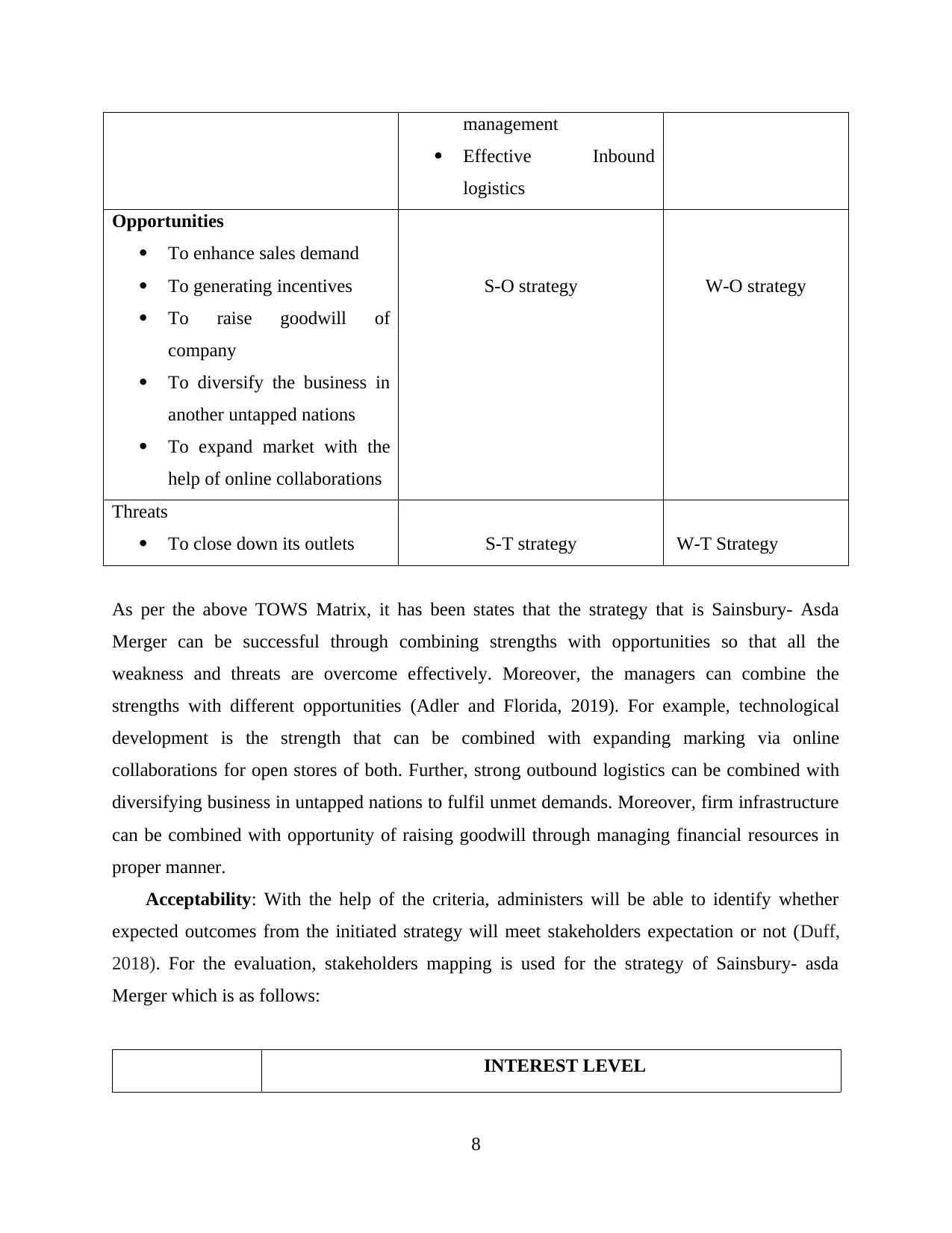
management
Effective Inbound
logistics
Opportunities
To enhance sales demand
To generating incentives
To raise goodwill of
company
To diversify the business in
another untapped nations
To expand market with the
help of online collaborations
S-O strategy W-O strategy
Threats
To close down its outlets S-T strategy W-T Strategy
As per the above TOWS Matrix, it has been states that the strategy that is Sainsbury- Asda
Merger can be successful through combining strengths with opportunities so that all the
weakness and threats are overcome effectively. Moreover, the managers can combine the
strengths with different opportunities (Adler and Florida, 2019). For example, technological
development is the strength that can be combined with expanding marking via online
collaborations for open stores of both. Further, strong outbound logistics can be combined with
diversifying business in untapped nations to fulfil unmet demands. Moreover, firm infrastructure
can be combined with opportunity of raising goodwill through managing financial resources in
proper manner.
Acceptability: With the help of the criteria, administers will be able to identify whether
expected outcomes from the initiated strategy will meet stakeholders expectation or not (Duff,
2018). For the evaluation, stakeholders mapping is used for the strategy of Sainsbury- asda
Merger which is as follows:
INTEREST LEVEL
8
Effective Inbound
logistics
Opportunities
To enhance sales demand
To generating incentives
To raise goodwill of
company
To diversify the business in
another untapped nations
To expand market with the
help of online collaborations
S-O strategy W-O strategy
Threats
To close down its outlets S-T strategy W-T Strategy
As per the above TOWS Matrix, it has been states that the strategy that is Sainsbury- Asda
Merger can be successful through combining strengths with opportunities so that all the
weakness and threats are overcome effectively. Moreover, the managers can combine the
strengths with different opportunities (Adler and Florida, 2019). For example, technological
development is the strength that can be combined with expanding marking via online
collaborations for open stores of both. Further, strong outbound logistics can be combined with
diversifying business in untapped nations to fulfil unmet demands. Moreover, firm infrastructure
can be combined with opportunity of raising goodwill through managing financial resources in
proper manner.
Acceptability: With the help of the criteria, administers will be able to identify whether
expected outcomes from the initiated strategy will meet stakeholders expectation or not (Duff,
2018). For the evaluation, stakeholders mapping is used for the strategy of Sainsbury- asda
Merger which is as follows:
INTEREST LEVEL
8
Secure Best Marks with AI Grader
Need help grading? Try our AI Grader for instant feedback on your assignments.
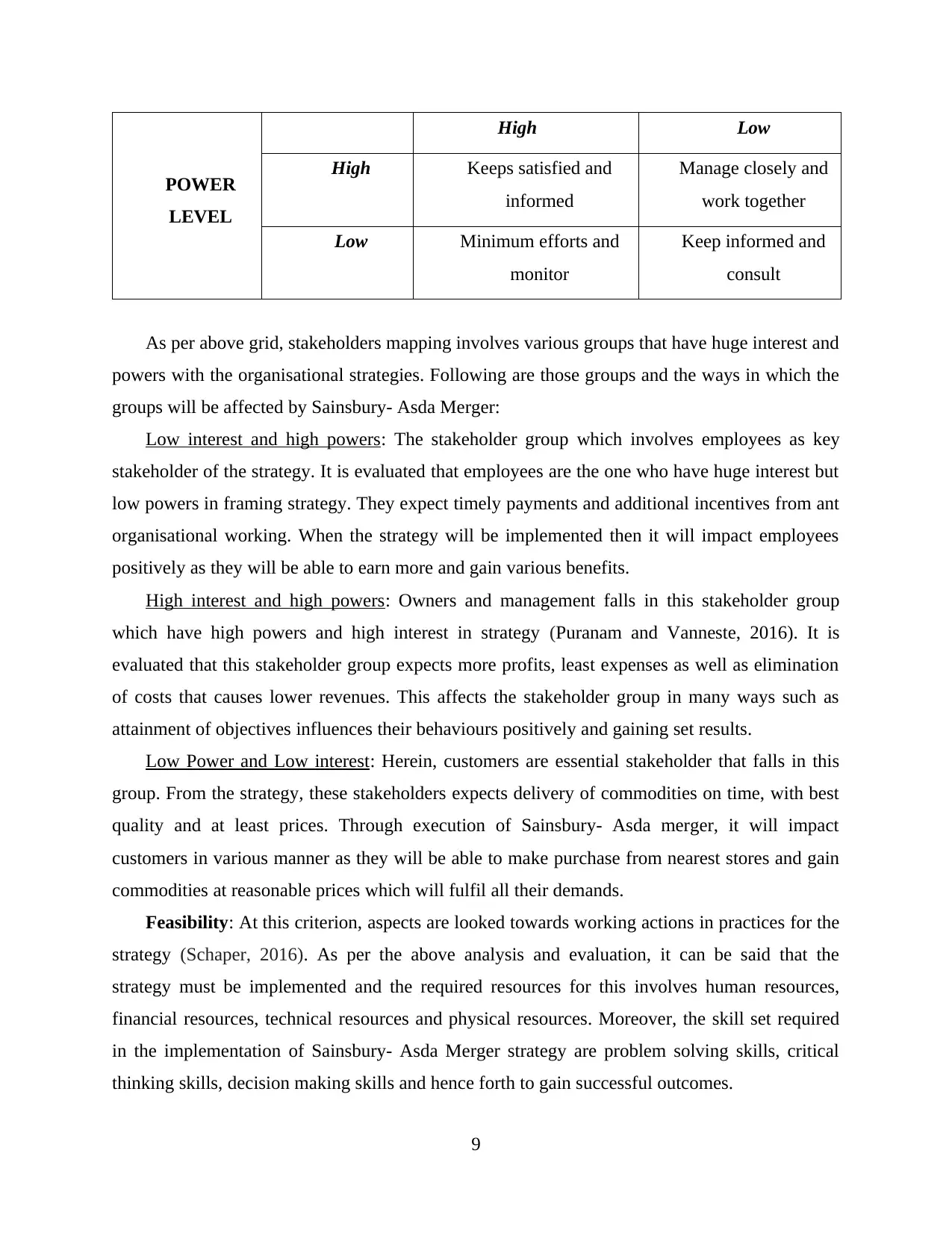
POWER
LEVEL
High Low
High Keeps satisfied and
informed
Manage closely and
work together
Low Minimum efforts and
monitor
Keep informed and
consult
As per above grid, stakeholders mapping involves various groups that have huge interest and
powers with the organisational strategies. Following are those groups and the ways in which the
groups will be affected by Sainsbury- Asda Merger:
Low interest and high powers: The stakeholder group which involves employees as key
stakeholder of the strategy. It is evaluated that employees are the one who have huge interest but
low powers in framing strategy. They expect timely payments and additional incentives from ant
organisational working. When the strategy will be implemented then it will impact employees
positively as they will be able to earn more and gain various benefits.
High interest and high powers: Owners and management falls in this stakeholder group
which have high powers and high interest in strategy (Puranam and Vanneste, 2016). It is
evaluated that this stakeholder group expects more profits, least expenses as well as elimination
of costs that causes lower revenues. This affects the stakeholder group in many ways such as
attainment of objectives influences their behaviours positively and gaining set results.
Low Power and Low interest: Herein, customers are essential stakeholder that falls in this
group. From the strategy, these stakeholders expects delivery of commodities on time, with best
quality and at least prices. Through execution of Sainsbury- Asda merger, it will impact
customers in various manner as they will be able to make purchase from nearest stores and gain
commodities at reasonable prices which will fulfil all their demands.
Feasibility: At this criterion, aspects are looked towards working actions in practices for the
strategy (Schaper, 2016). As per the above analysis and evaluation, it can be said that the
strategy must be implemented and the required resources for this involves human resources,
financial resources, technical resources and physical resources. Moreover, the skill set required
in the implementation of Sainsbury- Asda Merger strategy are problem solving skills, critical
thinking skills, decision making skills and hence forth to gain successful outcomes.
9
LEVEL
High Low
High Keeps satisfied and
informed
Manage closely and
work together
Low Minimum efforts and
monitor
Keep informed and
consult
As per above grid, stakeholders mapping involves various groups that have huge interest and
powers with the organisational strategies. Following are those groups and the ways in which the
groups will be affected by Sainsbury- Asda Merger:
Low interest and high powers: The stakeholder group which involves employees as key
stakeholder of the strategy. It is evaluated that employees are the one who have huge interest but
low powers in framing strategy. They expect timely payments and additional incentives from ant
organisational working. When the strategy will be implemented then it will impact employees
positively as they will be able to earn more and gain various benefits.
High interest and high powers: Owners and management falls in this stakeholder group
which have high powers and high interest in strategy (Puranam and Vanneste, 2016). It is
evaluated that this stakeholder group expects more profits, least expenses as well as elimination
of costs that causes lower revenues. This affects the stakeholder group in many ways such as
attainment of objectives influences their behaviours positively and gaining set results.
Low Power and Low interest: Herein, customers are essential stakeholder that falls in this
group. From the strategy, these stakeholders expects delivery of commodities on time, with best
quality and at least prices. Through execution of Sainsbury- Asda merger, it will impact
customers in various manner as they will be able to make purchase from nearest stores and gain
commodities at reasonable prices which will fulfil all their demands.
Feasibility: At this criterion, aspects are looked towards working actions in practices for the
strategy (Schaper, 2016). As per the above analysis and evaluation, it can be said that the
strategy must be implemented and the required resources for this involves human resources,
financial resources, technical resources and physical resources. Moreover, the skill set required
in the implementation of Sainsbury- Asda Merger strategy are problem solving skills, critical
thinking skills, decision making skills and hence forth to gain successful outcomes.
9
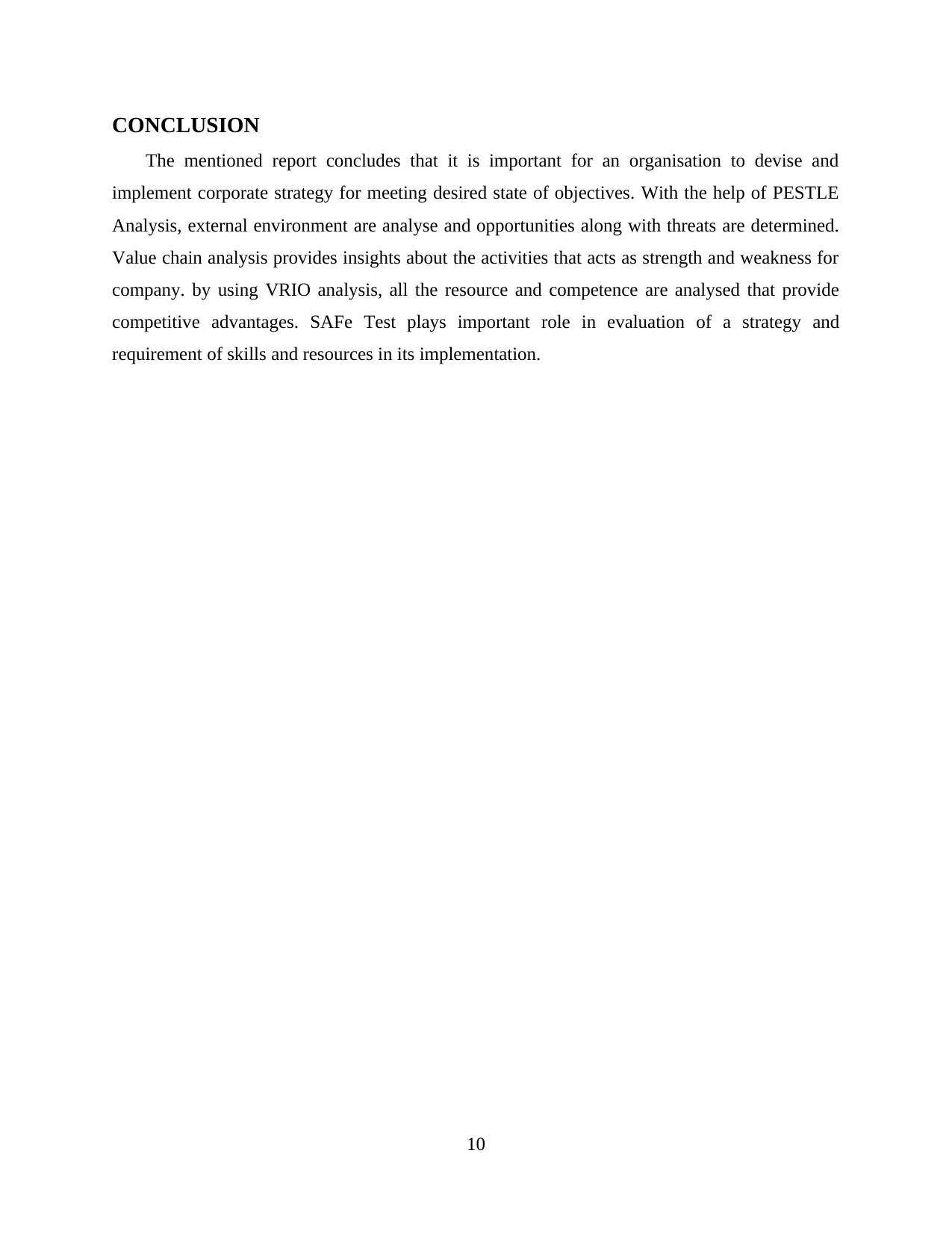
CONCLUSION
The mentioned report concludes that it is important for an organisation to devise and
implement corporate strategy for meeting desired state of objectives. With the help of PESTLE
Analysis, external environment are analyse and opportunities along with threats are determined.
Value chain analysis provides insights about the activities that acts as strength and weakness for
company. by using VRIO analysis, all the resource and competence are analysed that provide
competitive advantages. SAFe Test plays important role in evaluation of a strategy and
requirement of skills and resources in its implementation.
10
The mentioned report concludes that it is important for an organisation to devise and
implement corporate strategy for meeting desired state of objectives. With the help of PESTLE
Analysis, external environment are analyse and opportunities along with threats are determined.
Value chain analysis provides insights about the activities that acts as strength and weakness for
company. by using VRIO analysis, all the resource and competence are analysed that provide
competitive advantages. SAFe Test plays important role in evaluation of a strategy and
requirement of skills and resources in its implementation.
10
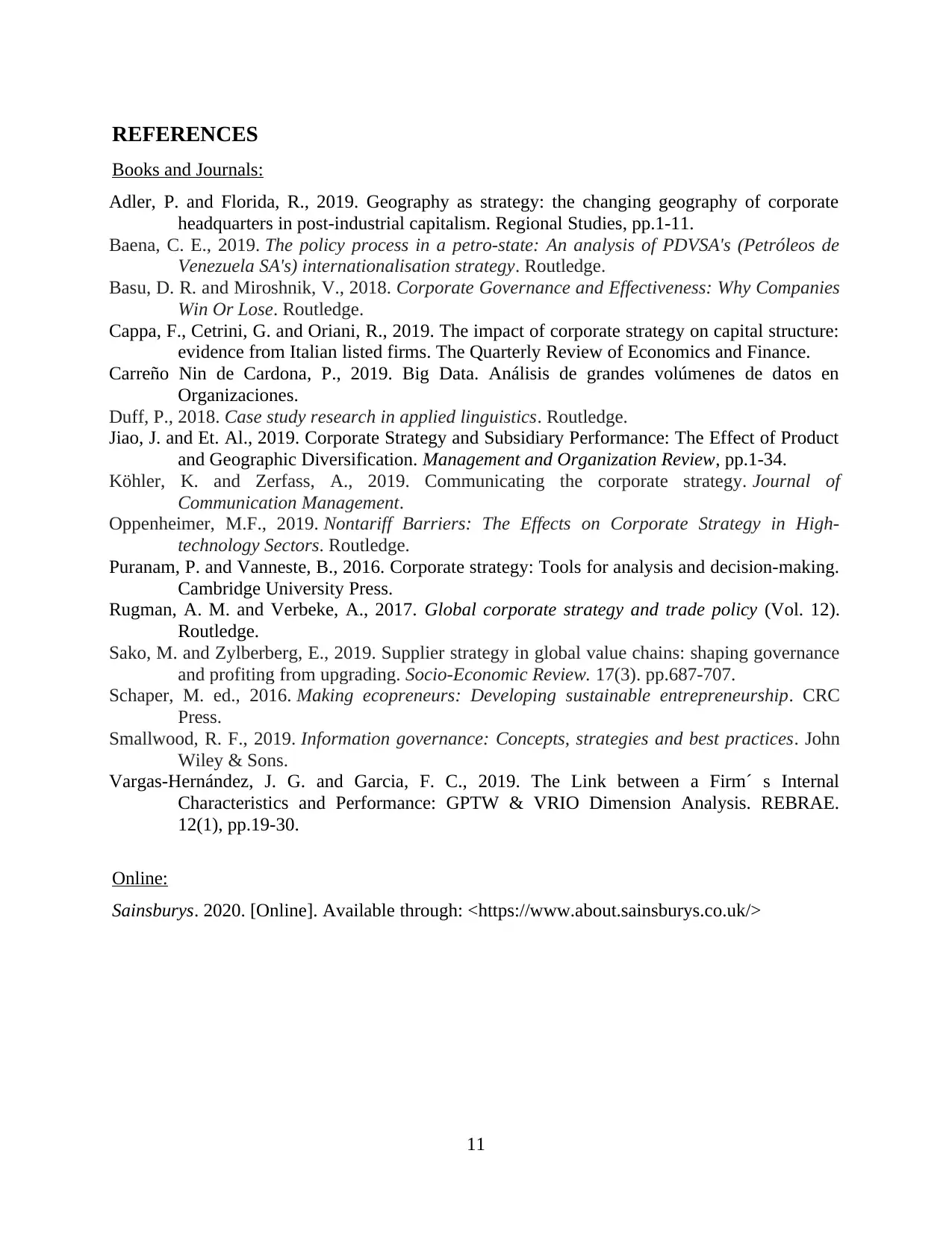
REFERENCES
Books and Journals:
Adler, P. and Florida, R., 2019. Geography as strategy: the changing geography of corporate
headquarters in post-industrial capitalism. Regional Studies, pp.1-11.
Baena, C. E., 2019. The policy process in a petro-state: An analysis of PDVSA's (Petróleos de
Venezuela SA's) internationalisation strategy. Routledge.
Basu, D. R. and Miroshnik, V., 2018. Corporate Governance and Effectiveness: Why Companies
Win Or Lose. Routledge.
Cappa, F., Cetrini, G. and Oriani, R., 2019. The impact of corporate strategy on capital structure:
evidence from Italian listed firms. The Quarterly Review of Economics and Finance.
Carreño Nin de Cardona, P., 2019. Big Data. Análisis de grandes volúmenes de datos en
Organizaciones.
Duff, P., 2018. Case study research in applied linguistics. Routledge.
Jiao, J. and Et. Al., 2019. Corporate Strategy and Subsidiary Performance: The Effect of Product
and Geographic Diversification. Management and Organization Review, pp.1-34.
Köhler, K. and Zerfass, A., 2019. Communicating the corporate strategy. Journal of
Communication Management.
Oppenheimer, M.F., 2019. Nontariff Barriers: The Effects on Corporate Strategy in High-
technology Sectors. Routledge.
Puranam, P. and Vanneste, B., 2016. Corporate strategy: Tools for analysis and decision-making.
Cambridge University Press.
Rugman, A. M. and Verbeke, A., 2017. Global corporate strategy and trade policy (Vol. 12).
Routledge.
Sako, M. and Zylberberg, E., 2019. Supplier strategy in global value chains: shaping governance
and profiting from upgrading. Socio-Economic Review. 17(3). pp.687-707.
Schaper, M. ed., 2016. Making ecopreneurs: Developing sustainable entrepreneurship. CRC
Press.
Smallwood, R. F., 2019. Information governance: Concepts, strategies and best practices. John
Wiley & Sons.
Vargas-Hernández, J. G. and Garcia, F. C., 2019. The Link between a Firm´ s Internal
Characteristics and Performance: GPTW & VRIO Dimension Analysis. REBRAE.
12(1), pp.19-30.
Online:
Sainsburys. 2020. [Online]. Available through: <https://www.about.sainsburys.co.uk/>
11
Books and Journals:
Adler, P. and Florida, R., 2019. Geography as strategy: the changing geography of corporate
headquarters in post-industrial capitalism. Regional Studies, pp.1-11.
Baena, C. E., 2019. The policy process in a petro-state: An analysis of PDVSA's (Petróleos de
Venezuela SA's) internationalisation strategy. Routledge.
Basu, D. R. and Miroshnik, V., 2018. Corporate Governance and Effectiveness: Why Companies
Win Or Lose. Routledge.
Cappa, F., Cetrini, G. and Oriani, R., 2019. The impact of corporate strategy on capital structure:
evidence from Italian listed firms. The Quarterly Review of Economics and Finance.
Carreño Nin de Cardona, P., 2019. Big Data. Análisis de grandes volúmenes de datos en
Organizaciones.
Duff, P., 2018. Case study research in applied linguistics. Routledge.
Jiao, J. and Et. Al., 2019. Corporate Strategy and Subsidiary Performance: The Effect of Product
and Geographic Diversification. Management and Organization Review, pp.1-34.
Köhler, K. and Zerfass, A., 2019. Communicating the corporate strategy. Journal of
Communication Management.
Oppenheimer, M.F., 2019. Nontariff Barriers: The Effects on Corporate Strategy in High-
technology Sectors. Routledge.
Puranam, P. and Vanneste, B., 2016. Corporate strategy: Tools for analysis and decision-making.
Cambridge University Press.
Rugman, A. M. and Verbeke, A., 2017. Global corporate strategy and trade policy (Vol. 12).
Routledge.
Sako, M. and Zylberberg, E., 2019. Supplier strategy in global value chains: shaping governance
and profiting from upgrading. Socio-Economic Review. 17(3). pp.687-707.
Schaper, M. ed., 2016. Making ecopreneurs: Developing sustainable entrepreneurship. CRC
Press.
Smallwood, R. F., 2019. Information governance: Concepts, strategies and best practices. John
Wiley & Sons.
Vargas-Hernández, J. G. and Garcia, F. C., 2019. The Link between a Firm´ s Internal
Characteristics and Performance: GPTW & VRIO Dimension Analysis. REBRAE.
12(1), pp.19-30.
Online:
Sainsburys. 2020. [Online]. Available through: <https://www.about.sainsburys.co.uk/>
11
1 out of 13
Related Documents
Your All-in-One AI-Powered Toolkit for Academic Success.
+13062052269
info@desklib.com
Available 24*7 on WhatsApp / Email
![[object Object]](/_next/static/media/star-bottom.7253800d.svg)
Unlock your academic potential
© 2024 | Zucol Services PVT LTD | All rights reserved.





